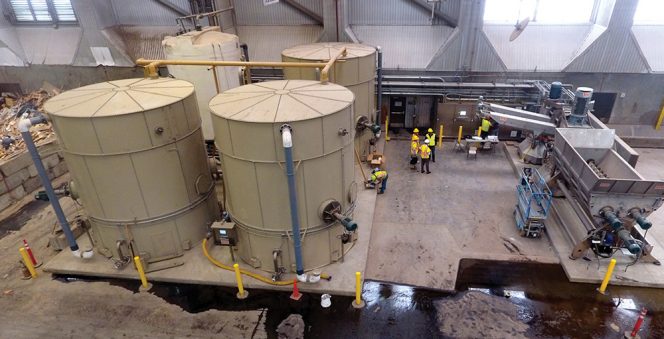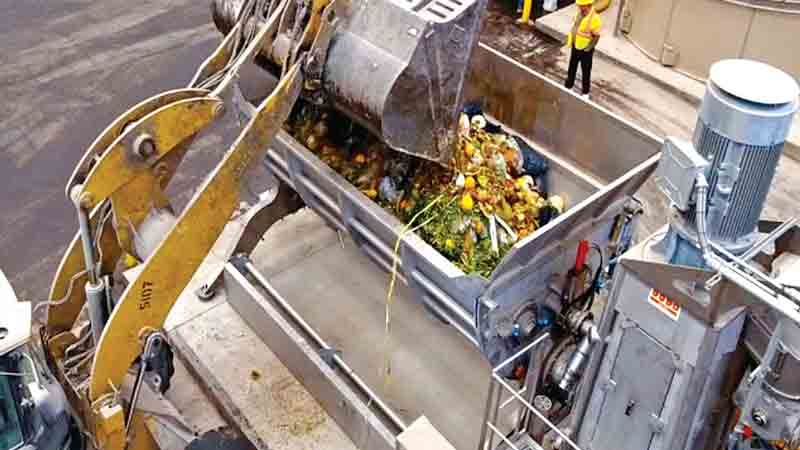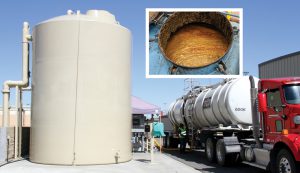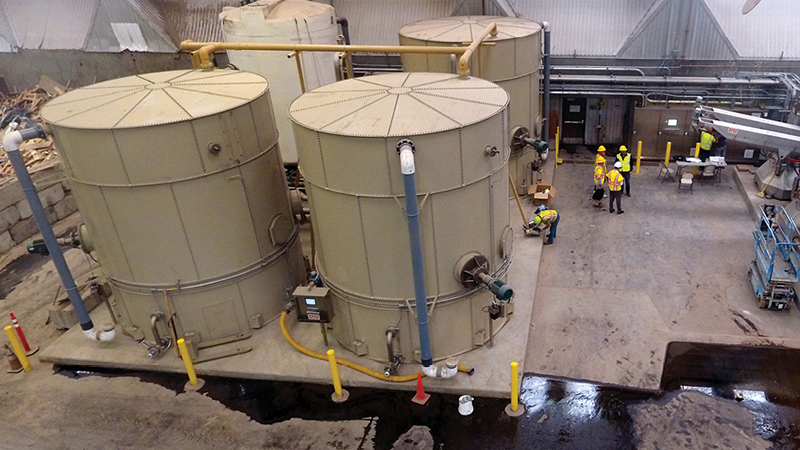Kelly Sarber

A designated space at the Puente Hills MRF includes the DODA bioseparators and storage tanks for the slurry (on right).
After a decade of evolving economics and logistics to generate more renewable energy production using increased volumes of source separated organics (SSO), Los Angeles County Sanitation Districts (the Districts) have pivoted to a full-fledged commercial operation, transitioning their pilot food waste digestion and biogas generating system into one of the nation’s largest integrated, food waste recycling programs. The steps to building a sustainable, municipal organics processing system are a reflection of their entrepreneurial staff, vision and collaborative culture.
The Districts are a regional agency and a confederation of 24 independent special districts working cooperatively under a Joint Administration Agreement, created under state law to serve the wastewater treatment and solid waste management needs of about 5.6 million people in Los Angeles County. The service area covers approximately 850 square miles and encompasses 78 cities and unincorporated territory within the county. The Districts’ flagship wastewater treatment plant is the Joint Water Pollution Control Plant (JWPCP), located in Carson. The plant treats an average of 280 million gallons/day (mgd) of wastewater from a service area of 3.5 million people.

Food waste from commercial generators is loaded into a hopper with augers that move the material to the bioseparators. Photo courtesy of Los Angeles County Sanitation Districts
At full build out, the Districts’ overall organics management system is sized to receive up to 550 tons/day of source separated food waste, with 165 tons/day coming from their processing operations at Puente Hills Materials Recycling Facilities (Puente Hills MRF). The other 385 tons/day will come from commercial haulers sending an engineered slurry directly to the JWPCP. This equates to approximately 14 percent of necessary capacity to process the 4,000 tons/day of food waste generated in the Los Angeles (LA) Basin. The Districts are actively seeking more contracted volumes from both public and private partners. Currently, 30 tons/day are being processed at the Puente Hills MRF and 150 tons/day are being received from other haulers, for a total of 180 tons/day being delivered to JWPCP.
“Our team has been disciplined in creating an overall systems approach to increasing organics processing capacity desperately needed in the LA Basin while minimizing risks to our wastewater treatment process,” explains Mark McDannel, Division Engineer in the Energy Recovery Section for the Districts. “Creating independent annuity streams to supplement payments for the delivery of essential wastewater treatment and waste collection services helps to maintain affordable rates for our constituents.” In addition to being paid competitive rates to process food waste from private sector generators, the Districts’ ability to effectively utilize an unlevered asset in the form of excess digestion capacity at the JWPCP has meant additional environmental benefits. These include meeting climate change goals and creating greenhouse gas credits due to a newfound ability to divert energy-rich food waste from landfills to generate renewable energy.
Key Drivers
Changing regulations were key drivers behind decisions by the Districts to further investigate systems approaches to organics management that would be economically advantageous while being conscious of their core mission to provide exemplary waste and wastewater management. Between 2011 and 2014, new legislation passed in California spurring removal of food waste from landfills. Passage of the Commercial Recycling Law (AB 341) set a policy goal that at least 75 percent of the solid waste generated in the state must be source reduced, recycled, or composted by 2020. As a result of AB 341, the Districts conducted a feasibility study and bench-scale research from 2011 to 2013 to evaluate codigestion of food scraps with sewage sludge at JWPCP.
The study concluded that the concept had technical merit, although economic merit could not be determined at the time. The main advantages were a lot of excess digester capacity, and operating expertise related to energy recovery from biogas. The unknowns were the impact of the food wastes on digester performance and on digestate quality, materials handling considerations related to managing a solid waste within a water resource recovery facility (WRRF), and the economics of codigestion.
Public Private Partnerships
The Districts have always been open to public-private partnerships and the evolution of their organics processing system is no exception. In 2008, Waste Management (WM) — recognizing growing interest in food waste diversion and servicing its franchise customers — decided to investigate how WM could develop new, technological solutions in Southern California for processing food waste streams. By 2009, WM had invested in a 75-plus tons/day pilot program for diverting food waste to anaerobic digesters from its Santa Ana transfer facility using commercially sourced, organic waste streams. It began bench-scale testing a processed food waste material from a DODA bioseparator for codigestion with other wastewater utilities. By 2012, WM had approached the Districts to pilot test its feedstock at JWPCP using the engineered slurry delivered in tanker trucks.
Against this backdrop, the Districts had been evaluating systems for digesting food waste and investigating many operating systems that claimed to be able to depackage and prepare a feedstock slurry for direct injection into a digester. “The Districts’ engineers found that the WM approach to create an engineered slurry using a DODA bioseparator machine to produce a homogeneous and fairly contaminant-free feedstock was a good fit for our sensitive digesters,” notes McDannel.
In addition, he and his team liked that the material was in a wet form — the slurry could be pumped into sealed storage tanks with recirculators that operated several minutes each hour to keep the slurry in suspension. Important to JWPCP engineers was that this sealed system reduced the potential for odors at the wastewater treatment plant, a key consideration for moving to commercial operations. This laid the groundwork for the Districts and WM to enter into an agreement for a four-year demonstration project (2014-2018) where WM would deliver 84 tons/day (200,000 gallons) of food waste slurry to the JWPCP.
At the JWPCP, sewage sludge from the primary and secondary activated sludge treatment system is anaerobically digested in 24 completely stirred tank reactors, each containing 3.7 million gallons. The reactors operate at 96°F (35°C) and have a hydraulic retention time of 18 days. For the demonstration project, the Districts designated one of its 24 anaerobic digesters as a test site so that it could isolate and study the impacts of using the engineered slurry over time. Injected into the test reactor at a rate of 9 percent of the liquid volume and 30 percent of the solids volume, the slurry contained about 250,000 mg/l COD with a volatile solids content of 91 percent with very little contamination. Staff discovered that adding 84 tons/day of engineered slurry (equivalent to 62 tons/day of raw food waste diverted from landfilling) resulted in generating an additional 100,000 cubic feet/day of biogas capable of producing an additional 200 kW of electricity.
Equipping The Transfer Station
In 2014, California’s Mandatory Commercial Organics Recycling Law (AB 1826) was passed, requiring businesses to recycle their organic waste after April 1, 2016, beginning with large generators. With the logistics of receiving and processing organics at the wastewater treatment plant bulletproofed, the Districts focused on their own waste processing activities to internally integrate them into solid waste operations.

A tanker truck unloads processed food waste slurry (above, left) into 15,000 gallon storage tanks. A typical tanker load is 4,600 to 4,800 gallons. Photo courtesy of Los Angeles County Sanitation Districts, Inset photo by Kelly Sarber
A designated space was set aside at the Puente Hills MRF. The Districts purchased a DODA bioseparator to start manufacturing slurry for up to 165 tons/day of food waste. During 2017-2018, it designed, permitted and built the necessary tanks, piping and support equipment. Employees were trained how to operate the system and pump the slurry into tanker trucks. The Districts began accepting contracted SSO volumes from franchise collectors in 2018. They also entered into contracts with seven private companies that deliver a food waste slurry under strict specifications directly to the wastewater treatment plant.
Operators manually sort and remove bags where practical before loading material into a hopper with an auger that feeds the bioseparators. The primary separator has a screen opening of 15 mm, followed by a secondary separator with a screen size of 8 mm. This sequential separation was identified during the demonstration project as effectively reducing contamination levels. Paddles are attached to a central shaft in the bioseparators. As the paddles spin, they grind and push organic material out through the screen, and move the inert material upward. At the top exit of the bioseparators, inert material is transported by an auger to a hopper for disposal. “We do some manual cleaning of the units to remove material like film plastic,” explains McDannel. “Cleaning the machine is more cost-effective than installing debagging equipment upstream of the bioseparators.”
Renewable Natural Gas
Currently, all food waste slurry from the Puente Hills MRF — 10 to 15 loads/week — is delivered to the Liquid Waste Disposal Station at JWPCP’s headworks. A typical load is about 4,600 to 4,800 gallons. “We are in design for a slurry receiving station that should be operational by mid-2020,” says McDannel. “Capacity will be 124 tons/day of diverted food waste. That will be fed into two of our digesters at a ratio of 30 percent food waste to 70 percent sludge on a solids basis. We are seeing an increase in digester gas production from our current set up. It is hard to measure precisely due to fluctuations in total plant gas production.”
The digesters produce about 5,000 standard cubic feet per minute (scfm) of biogas, some of which is used to keep the reactors mixed and heated. The remainder is scrubbed to remove particulates, dried to remove moisture and then compressed and chilled to serve as fuel for three gas turbines and one steam turbine-generator. The 20 MW of power generated from this combined-cycle power plant is used to meet all of the JWPCP’s electrical needs. “On an annual average basis we are net exporters [of electricity],” he adds. “In 2018, we generated an average of 20.7 MW, exported an average of 1.5 MW, and imported an average of 0.2 MW.”
The Districts own a compressed natural gas (CNG) vehicle fueling station that utilizes pipeline natural gas. A single-pass membrane filtration biogas conditioning system is being installed to purify the biogas, and associated delivery piping, to produce 760,000 gasoline gallon equivalents/year (GGE) of renewable natural gas (RNG), with an estimated revenue of $2 million annually based on current market conditions. The project cost is estimated to be $5.4 million. A California Energy Commission grant is funding up to $2.5 million of the project.
The Districts are in discussions with Southern California Gas about using the cleaned biogas from additional food waste digestion for biomethane injection into the natural gas distribution grid. Research suggests that a biomethane injection project could take up to 1,040 cfm of RNG, which would come from about 375 additional tons/day of diverted food waste through the digesters.
Kelly Sarber is Managing Director at SER Capital Partners.













